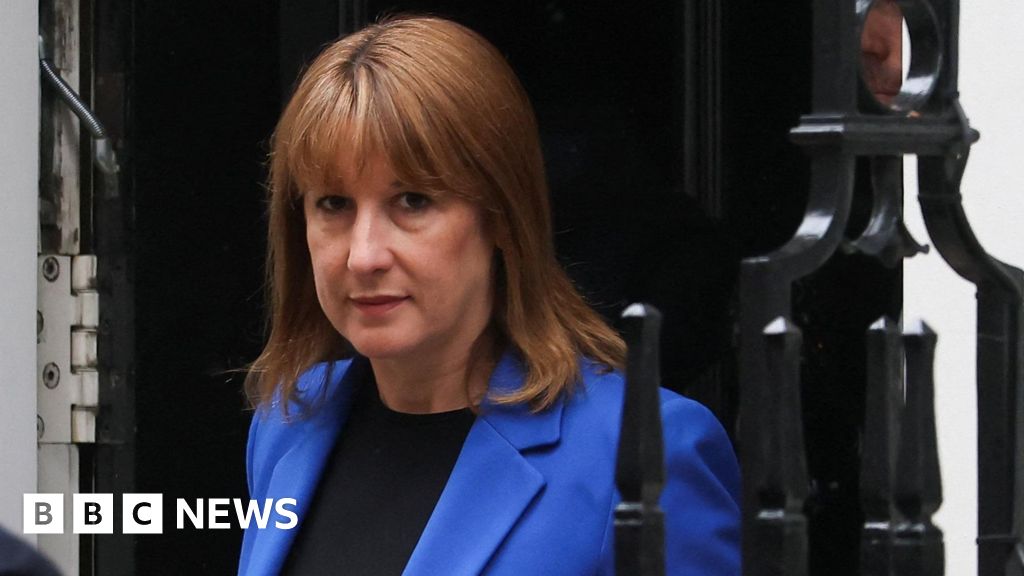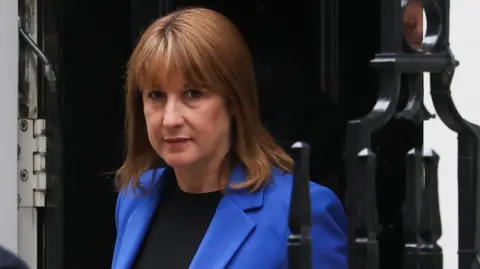Business
UK borrowing costs hit 27-year high adding to pressure on Reeves

Tom Espiner & Nick EdserBusiness reporters, BBC News
 Reuters
ReutersUK government borrowing costs have reached their highest level since 1998, adding to the pressure on the chancellor ahead of the Budget.
The interest rate on 30-year government bonds, known as the yield, jumped to 5.698%, making it more expensive for the government to borrow money.
There are rising expectations that Chancellor Rachel Reeves will increase taxes in the Budget later this year in order to meet her borrowing and spending rules, as worries grow about the state of the government’s finances.
On the currency markets, the pound also fell more than 1% against the dollar on Tuesday.
Sterling dropped to $1.3379, which is the lowest level against the US currency since 7 August.
The UK was not alone in seeing borrowing costs rise, with yields on 30-year German, French and Dutch bonds climbing to their highest 2011.
A number of factors have led to borrowing costs for governments around the globe to go up, such as geopolitical tensions, US President Donald Trump’s trade policies and the upcoming confidence vote in the French government.
‘Difficult choices’
But Susannah Streeter, head of money and markets at Hargreaves Lansdown, said the chancellor faced “highly difficult choices” in the Budget and that she had been “dealt a warning” by investors.
“They are selling off UK government debt, clearly concerned that the government may be losing its grip on the public finances,” she said.
In its manifesto, Labour promised not to raise taxes such as income tax, VAT or national insurance on “working people”. This has led to much speculation over what taxes Reeves could raise in the autumn Budget.
One option suggested is that the freeze on income tax thresholds, which is due to end in 2028, could be extended.
Often referred to as a “stealth tax”, freezing income tax thresholds means that, over time as salaries rise, more people are dragged into paying higher rates.
There have also been reports that Reeves is considering reforming property taxes.
“With so many options for raising taxes being bandied about during the summer, there appears to be concern that the decisions made might not be sufficiently thought through,” said Ms Streeter.
“The worry isn’t just that government coffers won’t be replenished, but that they will be filled at the expense of growth, leading to a vicious circle emerging.”
On Monday, the government announced a partial reshuffle, with Darren Jones, formerly Reeves’s deputy, being given a key No 10 role by the prime minister.
The changes are focused on beefing up the economic know-how in Downing Street. Baroness Shafik, a former deputy governor of the Bank of England, has been named at Keir Starmer’s new chief economic adviser.
The moves are a recognition that the upcoming autumn’s Budget will be a defining moment in this Labour government.
Governments borrow money from investors by selling bonds – which is a loan the government promises to pay back at the end of an agreed time.
The yield on 30-year UK government bonds – known as gilts – has been rising for some months, and this makes it more expensive for the government to borrow money due to higher interest payments.
The government’s official forecaster, the Office for Budget Responsibility (OBR), takes borrowing costs into account when looking at whether the chancellor is meeting her self-imposed fiscal rules.
When she became chancellor, Reeves set out two rules on government borrowing, which she has repeatedly said are “non-negotiable”. These were:
- day-to-day government costs will be paid for by tax income, rather than borrowing by 2029-30
- to get debt falling as a share of national income by the end of this parliament in 2029-30
Part of the reason Reeves is under pressure is that her financial buffer to stick to these rules is a relatively slim £10bn. The chancellor recently refused to rule out tax rises after disappointing data on economic growth.
On Tuesday, a spokesperson for Starmer said the government’s “iron-clad commitment to our robust fiscal rules remains”, adding it had made the necessary decisions to “stabilise the public finances”.
But shadow chancellor Mel Stride said the latest market movements were “another economic disaster from Rachel Reeves – and a clear vote of no confidence in Labour from the markets”.
“With more tax rises on the horizon, the economy is now in a precarious position,” he added.
There has been a wide range of forecasts for how much money Reeves might need to raise in the Budget to meet her rules.
One factor that will influence this is the borrowing costs facing the government.
When the OBR makes makes its forecasts for government debt it looks at yields on all bonds.
Paul Dales, chief UK economist at Capital Economics, said concerns about the path of UK inflation and interest rates, combined with global issues, were pushing UK government borrowing costs up.
In addition, he added that pension funds were also not buying as much long-term government debt due to the change in recent years from defined-benefit to defined-contribution schemes.
Mr Dales said Reeves would have to raise between £18bn and £28bn in the Budget to avoid breaking her fiscal rules, and to maintain her £10bn buffer.
Households and banks “will probably feel the brunt of the higher taxes”, he said.
Business
How To Apply For Insurance Claim After Accident? Where Does Licence Validity Come In? | Explained

Last Updated:
Even if your driving licence has expired, the law protects accident victims. Learn how insurance claims work and what the 30-day grace period covers
The rules for insurance claims following a road accident differ depending on whether it is a third-party claim or an own damage claim.
The Punjab and Haryana High Court has clarified that a driving licence remains valid for 30 days after its expiry. If an accident occurs on the 30th and final day of this grace period, the insurance company is legally required to honour the claim.
According to The Tribune, the licence in the case under consideration expired on June 4, 2001. The 30-day grace period began on June 5, meaning the licence remained valid until July 4, 2001. The accident took place on July 4, 2001, at around 10:45 am, and as it fell within the grace period, the licence was deemed legally valid.
Insurance Claims In India: What The Law Says
The rules for insurance claims following a road accident differ depending on whether it is a third-party claim or an own damage claim.
Third-Party Insurance: Mandatory for All Vehicles
Under Section 146 of the Motor Vehicles Act, 1988, third-party insurance is compulsory for every vehicle in India. Third-party claims relate to:
- Injury or death of a third party
- Damage to third-party property
The Supreme Court has consistently ruled that even if the driver has no licence, an expired licence, a suspended licence or a licence of the wrong category, the insurance company must still compensate the victim or their family.
This obligation remains even if:
- The driver has no driving licence at all
- The licence has expired
- The licence is suspended
- The licence belongs to an incorrect vehicle category
- The driver only holds a learner’s licence
‘Pay and Recover’ Principle
The Supreme Court frequently applies the pay and recover principle:
- The insurer must first pay compensation to the victim.
- The insurer may then recover the amount from the vehicle owner.
In 2023, the Supreme Court reaffirmed that the victim must not suffer because the driver lacked a valid licence.
Own Damage Claims: Strict Rules Apply
The rules for own damage claims are entirely different. Every motor insurance policy clearly states that the driver must have:
- A valid driving licence
- A proper licence for the vehicle category
If, at the time of the accident:
- The driver had no licence, or
- The licence had expired, or
- The licence was not appropriate for that vehicle,
the insurance company will reject the own damage claim entirely.
This position was upheld by the Supreme Court in Dharmendra Goyal vs Reliance General Insurance (2022) and reaffirmed in multiple judgements between 2023 and 2025.
The National Consumer Commission (NCDRC) issued similar rulings in dozens of cases.
Grace Period And Licence Validity
If an accident occurs within the 30-day grace period after the licence has expired, insurance policies provide full coverage, both for:
- Third-party claims, and
- Own damage claims
This rule is applicable nationwide.
When Is Renewal Necessary?
According to Section 15 of the Motor Vehicles Act, 1988 and the Central Motor Vehicles Rules, 1989:
30-Day Grace Period
- The licence remains fully valid for 30 days after expiry.
- There is no penalty if renewed within these 30 days.
Penalties After The Grace Period
- After 30 days: Rs 300 fine, increasing to Rs 1,000 per year.
- After 1 year: The applicant must take the driving test again.
- After 5 years: A complete restart is required, including a new learner’s licence.
Renewal Made Easier (2025 Guidelines)
The Ministry of Transport’s 2025 guidelines confirm:
- The 30-day grace period applies across India.
- Driving licences can be renewed instantly online via the Parivahan.gov.in portal.
December 08, 2025, 14:12 IST
Read More
Business
IndiGo Shares Sink Over 6.5% Amid Ongoing Flight Disruptions

Mumbai: Shares of InterGlobe Aviation, the parent company of IndiGo Airlines, fell sharply in early trade on Monday, dropping 6.6 per cent to an intra-day low of Rs 5,015 on the BSE.
However, it recovered later as around 9:45 a.m., the shares were trading at Rs 5,159.50, down by Rs 211 or 3.93 per cent.
The sell-off came after the Directorate General of Civil Aviation (DGCA) extended the deadline for IndiGo CEO Pieter Elbers to respond to a show-cause notice linked to the airline’s recent operational disruptions.
The aviation regulator had issued a show-cause notice to IndiGo’s accountable manager on Sunday, just a day after sending a similar notice to CEO Pieter Elbers.
The DGCA said that the airline’s massive wave of cancellations over the past week caused widespread inconvenience and distress to passengers across the country.
According to the regulator, the disruptions were largely triggered by IndiGo’s failure to plan properly for the rollout of the revised Flight Duty Time Limitations (FDTL) rules.
These rules, which lay down the duty hours and mandatory rest periods for flight crew, came into effect recently and have created significant operational challenges for the airline.
In its notice, the DGCA pointed out that IndiGo’s “large-scale operation failures” suggest major lapses in planning, oversight and resource management.
The accountable manager has been given 24 hours to explain why enforcement action should not be taken. If the airline fails to respond within the extended deadline, the DGCA has said it will proceed based on the information available.
Even as the regulatory pressure increases, IndiGo said on Sunday that it has restored 95 per cent of its network and plans to operate around 1,500 flights.
The airline claimed that its operations are on track to stabilise by December 10, with improving on-time performance and fewer cancellations.
However, more than 220 flights had already been cancelled across major airports by the time of reporting, adding to the inconvenience faced by thousands of passengers.
Business
Trump raises potential concerns over $72bn Netflix-Warner Bros deal

US President Donald Trump has flagged potential concerns over Netflix’s planned $72bn (£54bn) deal to buy Warner Brothers Discovery’s movie studio and popular HBO streaming networks.
At an event in Washington DC on Sunday, he said Netflix has a “big market share” and the firms’ combined size “could be a problem”.
On Friday, the two companies said they had reached an agreement that could bring Warner Brothers’ franchises like Harry Potter and Game of Thrones to Netflix, creating a new media giant.
The planned deal, which has raised concerns among some in the industry, is yet to be approved by competition authorities. The BBC has contacted Warner Brothers, Netflix and the White House for comment.
Launched in 1997 as a postal DVD rental business, Netflix has grown to become the world’s largest subscription streaming service. The deal – the biggest the film industry has seen in a long time – would cement its number one position.
Under the agreement several global entertainment franchises, such as Looney Tunes, The Matrix and Lord of the Rings, would move to Netflix.
The US Justice Department’s competition division, which oversees major mergers, could contend that the deal violates the law if the combined businesses account for too much of the streaming market.
At an event at the John F. Kennedy Center in the US capital, Trump said that Netflix has a “very big market share” which would “go up by a lot” if the deal goes ahead.
Trump added that he would be personally involved in the decision on whether or not to approve the deal and repeatedly highlighted the size of Netflix’s market share.
He also said that Netflix’s co-CEO Ted Sarandos recently visited the Oval Office and praised him for his work at the company.
“I have a lot of respect for him. He’s a great person,” said Trump. “He’s done one of the greatest jobs in the history of movies.”
Mr Sarandos earlier acknowledged that the agreement may have surprised investors but said it was a chance to position Netflix for success in the “decades to come”.
Some in the entertainment industry have criticised the agreement.
The Writers Guild of America’s East and West branches called for the merger to be blocked, saying the “world’s largest streaming company swallowing one of its biggest competitors is what antitrust laws were designed to prevent.”
“The outcome would eliminate jobs, push down wages, worsen conditions for all entertainment workers, raise prices for consumers and reduce the volume and diversity of content for all viewers,” it said on Friday.
-

 Tech1 week ago
Tech1 week agoGet Your Steps In From Your Home Office With This Walking Pad—On Sale This Week
-

 Sports1 week ago
Sports1 week agoIndia Triumphs Over South Africa in First ODI Thanks to Kohli’s Heroics – SUCH TV
-

 Fashion1 week ago
Fashion1 week agoResults are in: US Black Friday store visits down, e-visits up, apparel shines
-

 Entertainment1 week ago
Entertainment1 week agoSadie Sink talks about the future of Max in ‘Stranger Things’
-

 Politics1 week ago
Politics1 week agoElon Musk reveals partner’s half-Indian roots, son’s middle name ‘Sekhar’
-

 Tech1 week ago
Tech1 week agoPrague’s City Center Sparkles, Buzzes, and Burns at the Signal Festival
-

 Sports1 week ago
Sports1 week agoBroncos secure thrilling OT victory over Commanders behind clutch performances
-

 Sports1 week ago
Sports1 week agoF1 set for final-race showdown as Verstappen exploits McLaren blunder | The Express Tribune





